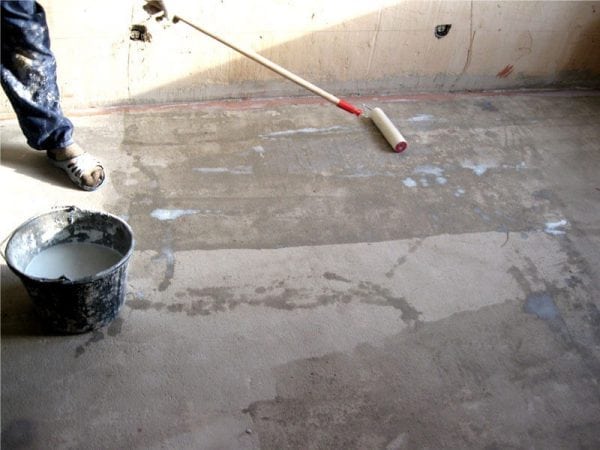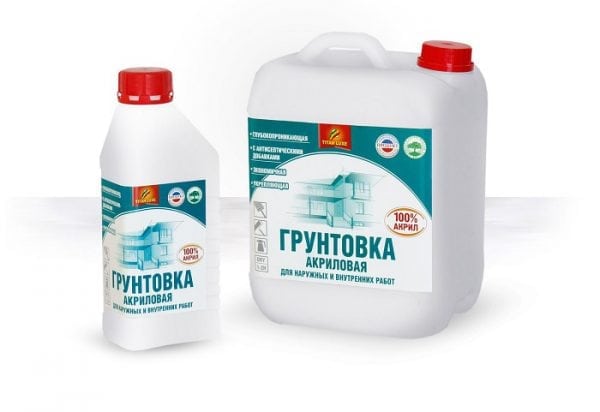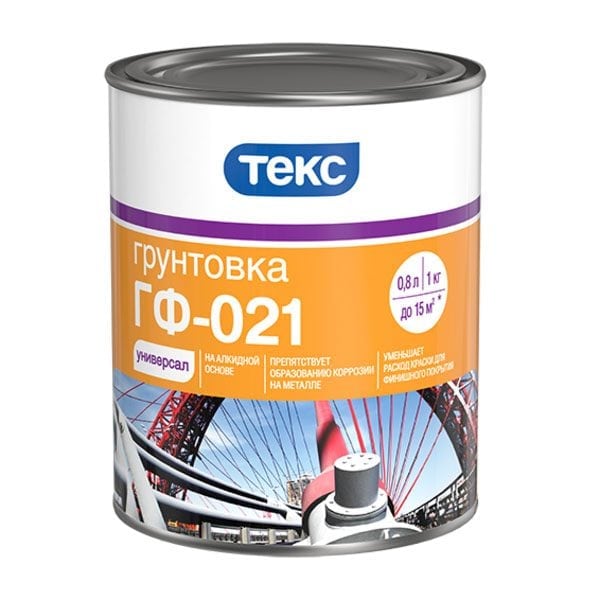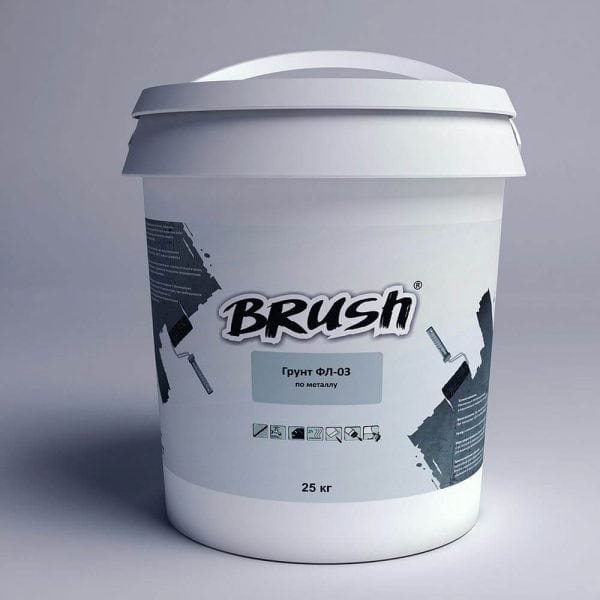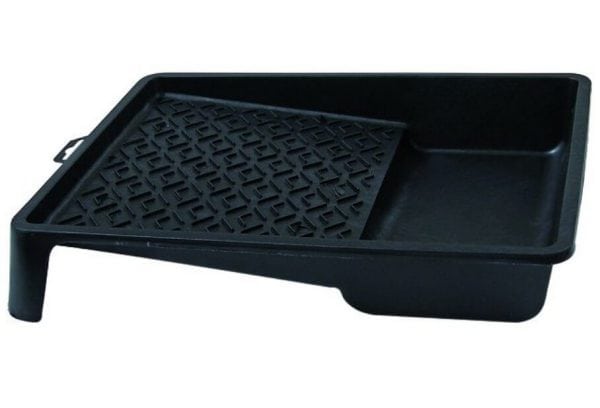To improve the adhesion of facing materials with the porous surface of the concrete screed, a special primer for the floor is used. Today in the market of building materials you can find many such solutions that vary in scope and composition.
- Varieties of primers in composition and scope
- Do it yourself primer on the floor surface
- Tool preparation
- Room cleaning
- Application of the mixture
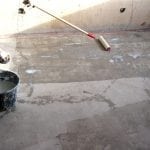
It may seem to many that the primer of floors is not a necessary measure, since such a solution is quite expensive, and the result of its application is visually invisible. However, if you refuse to treat the concrete floor with a special primer, then at the stage of finishing its surface you can experience many problems that will significantly slow down the pace of repair work and lead to additional costs.
What does a primer do? After complete solidification, such a solution creates a thin polymer protective layer on the floor surface, which positively affects:
- Adhesion enhancement. Deep penetration soil completely fills the pores of the concrete screed, which significantly improves the degree of adhesion of facing materials of various types. No matter how many microcracks there are on the surface of the screed, the solution will completely level the surface for maximum adhesion.
- Increased moisture resistance. A thin layer of primer solution provides a reduction in moisture absorption, which significantly reduces the cost of adhesive mixtures during surface finishing and eliminates the likelihood of a fungus under the facing materials.
- Integrity protection. Special primer for concrete surface will significantly slow down the process of microcracks during the operation of the finished floor.
to contents ↑
Varieties of primers in composition and scope
If you want to get a positive result from surface treatment with soil, then you should pay special attention to the composition of such a solution, its scope and main characteristics.
- Alkyd primer. Such a solution can be used to treat a wooden floor. After complete drying, the soil makes the surface rough and slightly swollen, which maximizes adhesion to all types of facing materials. At room temperature, the primer dries within 10-15 hours. This solution does not contain any components harmful to human health, therefore, if necessary, it can be used for processing any residential premises. In order to better protect the surface, it is necessary to apply such a primer in at least two layers.
- Acrylic primer. Soil can be used for processing wooden floors, concrete screed, plaster and even plywood. The acrylic primer mix penetrates deep into the base of the surface, completely filling the pores and ensuring high-quality adhesion of any finishing materials.Such a solution is not recommended to treat metal surfaces, as it can provoke the occurrence of corrosive processes. The deep penetrating primer for concrete floors can be used both for new concrete screeds and for surfaces that have already undergone minor damage. The acrylic primer dries within five hours.
- Gliftal primer. Such a solution is used for processing metal surfaces, but if desired, it can also be used for a wooden floor with normal room humidity. The soil dries better at room temperature, and complete solidification is achieved literally within half an hour. Most often, glyptal primer is used to improve the adhesion of the surface to enamel paints. In addition, coloring pigments are part of the solution, due to which, by choosing the right color of the soil, you can enhance the color rendering of the paintwork. How much such soil is needed for full processing depends on the surface condition.
- Perchlorovinyl primer. A solution of this type can be used to treat any surface, including metal and wood. At normal room temperature, the solution dries within one hour. It is worth noting that the composition of such a protective coating includes toxic components, so it is undesirable to use it for processing residential premises. The main advantage of the soil is its ability to stop corrosion processes that have already begun.
- Polyvinyl acetate primer. This synthetic base primer is best suited for surface pretreatment before applying polyvinyl acetate dyes. The soil dries within thirty minutes. Deep penetration mortar is used to protect concrete screed, brick or masonry. The presence of a coloring pigment in the composition of the soil provides enhanced color rendering of paints and varnishes.
- Phenolic primer. Primers of this type are used for the treatment of wooden surfaces and metal floors before subsequent painting. Given how much such soil has components that are harmful to human health, it is not recommended for use in residential premises. At room temperature, the solution dries in 10-15 hours.
- Polystyrene primer. Deeply penetrating primer mixture that can be coated on a wooden or metal floor before applying facing materials or paintwork. The composition of the solution includes a large number of toxic components, so it is better not to use it for processing residential premises. Such soil is more suitable for protecting a wooden floor on a veranda, porch or other surfaces that are outdoors. How much such a solution you need to fully treat the entire area depends on the surface condition.
Do it yourself primer on the floor surface
In order for your chosen primer for concrete floor to fully fulfill its function, you need to carry out work on its application in strict accordance with the technology. Guided by step-by-step instructions, you will perform surface treatment extremely quickly and simply.
Tool preparation
In order for the process of applying the soil to go quickly, you need to prepare in advance a set of certain tools that you can buy at any specialized store. For high-quality application of a primer on a concrete floor, you will need:
- a set of brushes of different widths and shapes for processing the most inaccessible places on the floor surface;
- for high-quality screed processing it is better to use a roller with a long or short pile (depending on the type of primer solution);
Long and short nap rollers - for greater convenience, you also need to pre-purchase a special container in which you will apply the solution to the surface of the roller and brushes.
Room cleaning
In order to get a high-quality result from a single application of the primer, it is necessary to thoroughly clean the floor surface from the smallest dirt and building dust. In this case, it is best to use a construction vacuum cleaner that will completely collect dust from the entire surface area in just a few minutes.
Application of the mixture
This stage is not very time-consuming, but very responsible, since the result of its implementation directly depends on how soon you can begin to finish the surface.
- If you bought the mixture in dry form, then dilute it with water at room temperature in accordance with the manufacturer's instructions. If you prefer the ready-made solution, then just open the bottle and pour some of the liquid into the prepared container.
- Next, you need to carefully process with the help of brushes all the corners of the room and hard-to-reach areas of the floor.
- The last step in applying a primer is to treat the main surface area of the floor with a roller. Start applying the primer from the corner farthest from the door and gradually move towards the exit, carefully staining every square centimeter.
- On average, it takes three to ten hours for the primer to completely dry, depending on its composition. Do I need to primer the floor again? Of course you need! After the applied primer is completely dry, it is necessary to apply a second layer of a solution of the same brand to create the necessary level of waterproofing and adhesion.
Conclusions: Primer concrete floor - this is a mandatory measure that must be correctly performed before applying the finish cladding. This is the only way to ensure high-quality adhesion of any finishing materials and significantly extend the service life of the concrete floor covering.

